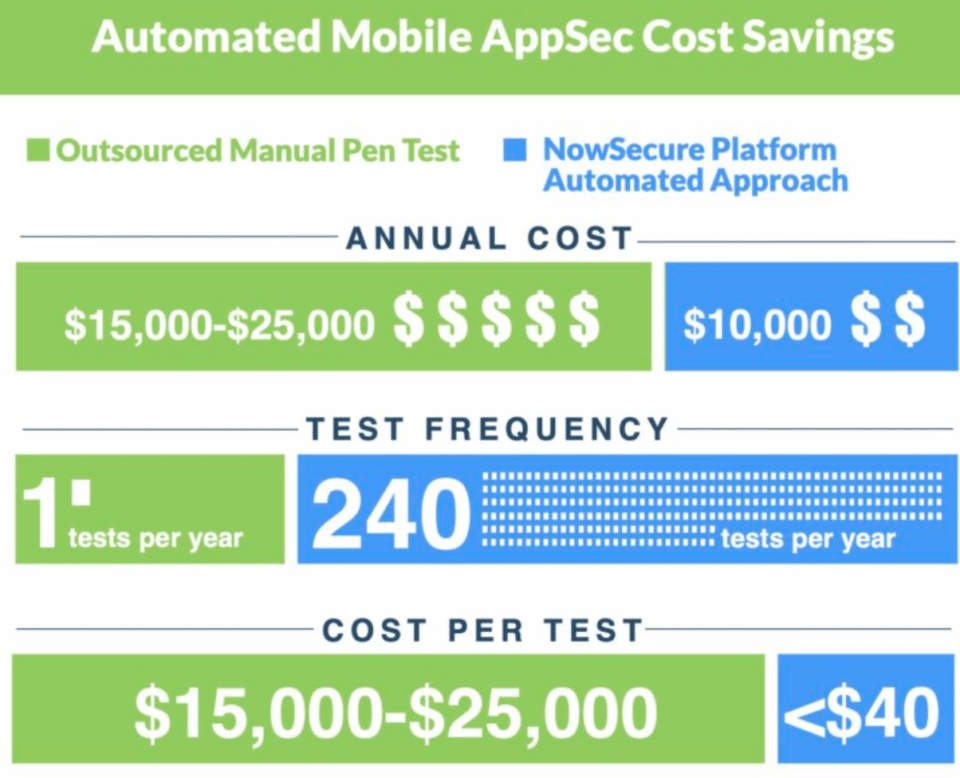If you learned there was a way to reduce mobile application security testing costs by up to 85% and achieve a 10x gain in productivity, wouldn’t that be compelling? Replacing manual mobile pen testing with integrated mobile application security testing in the software development lifecycle yields significant savings and productivity gains and simultaneously reduces risk.

In a slowing economy, savvy business leaders scrutinize their budgets for money-saving opportunities. Many have already been required to trim expenses or are facing the likelihood of budget reductions in their 2023 business plans. In reality, outsourcing traditionally has been one of the first things to get cut or organizations may place tools purchases on hold. Because mobile applications act as a key sales channel, means of customer engagement and employee productivity tool, protecting them remains critical. In fact, industry observers expect cyberattacks to grow in a recession as more people struggle financially and organizations might cut corners on security expenses. Insecure mobile apps can have a disastrous effect on the bottom line through damaged brand reputation, loss of customer trust, diminished company value, regulatory fines and legal settlements.
Shifting left in the pipeline with mobile DevSecOps test automation empowers mobile application development and mobile security teams to perform continuous security testing at a fraction of the cost of manual pen testing.
The good news is that organizations don’t have to compromise mobile app security and privacy to reduce spending. Shifting left in the pipeline with mobile DevSecOps test automation empowers mobile application development and mobile security teams to perform continuous security testing at a fraction of the cost of manual pen testing. What’s more, fixing security issues earlier in the development process in turn saves money and optimizes the delivery of high-quality mobile apps.
How Automation Saves Security Budgets
To be clear, performing periodic manual pen testing continues to be a key best practice for highly sensitive mobile apps, major new releases and those with complex requirements. But whether organizations outsource pen testing to a service provider or have a security analyst on staff to perform the assessment, the process traditionally costs too much, takes too long and happens too late in the development process to regularly occur. Automating mobile application security and supplementing it with occasional manual pen testing makes sense for more than financial reasons alone.
Discover several ways mobile application security and DevSecOps teams can use the NowSecure Platform automated mobile AppSec testing tool to reduce testing costs and save money.
- Replace external pen testing with automation. Say a mobile app pen test costs $15,000 – $25,000. If you outsource two to four each year, that costs $30,000 – $100,000 for a single app. Conducting unlimited security testing throughout the year on each and every build with NowSecure Platform runs about $40 per day, or a savings between 50% and 85% of a single outsourced pen test. Then engage NowSecure Services’ expert pen testers when you occasionally need the highest level of converge and depth or opt for Guided Testing with combines the power of automated testing with hands-on navigation from a NowSecure Services expert to assess apps with anti-automation features such as two-factor authentication, multi-factor authentication, CAPTCHA and QR codes. Guided testing offers an attractive cost-savings strategy where four guided tests during the year cost the same as one single outsourced pen test.
- Enhance employee productivity with automated mobile AppSec testing. Perhaps you have an internal mobile security analyst or team to safeguard mobile apps. Deploying NowSecure Platform greatly enhances productivity by automating some 80% of the work of a traditional pen test. While a traditional manual pen test takes about two weeks to complete, analysts can run an automated assessment in less than an hour for a significant labor reduction that translates into a 10x productivity gain.
- Integrate mobile DevSecOps testing into the CI/CD toolchain. Shifting security testing left reduces the cost of mobile app development because it’s less expensive to fix security issues earlier in the SDLC. For at least 30% less than the cost of a single pen test, you can autonomously test every build of every app, every single business day of the year. Continuous testing enables fast feedback loops that drive developer productivity and improve their skills.
- Help developers fix security bugs with embedded remediation advice. NowSecure Platform includes useful remediation guidance such as evidence of the security bug, details about how to fix it, code examples and links to Android and iOS documentation. Instead of wasting hours or even days trying to find the problem, developers can tap these resources to quickly resolve security issues and get back to writing new code. Security automation with embedded remediation reduces both security and development costs.
- Train devs on mobile security so they build secure apps from the start. Every security bug wastes time and money, creating inefficiencies in the SDLC. Upskilling devs on secure coding practices and common mobile application security issues to avoid through NowSecure Academy free online courseware can prevent them from making many of those mistakes in the first place. Putting out high-quality work means they write higher-quality code, reduce security testing costs due to fewer security issues found, have fewer issues to repair, which in turn reduces development costs and gets revenue-generating features into the hands of customers faster.
Replacing manual pen testing with the NowSecure automated mobile AppSec testing solution generates dramatic savings at scale, all for a price that doesn’t break the bank. Reach out for a NowSecure Platform demo and discuss how the tool can bring cost efficiencies to mobile app security and DevSecOps teams alike.





